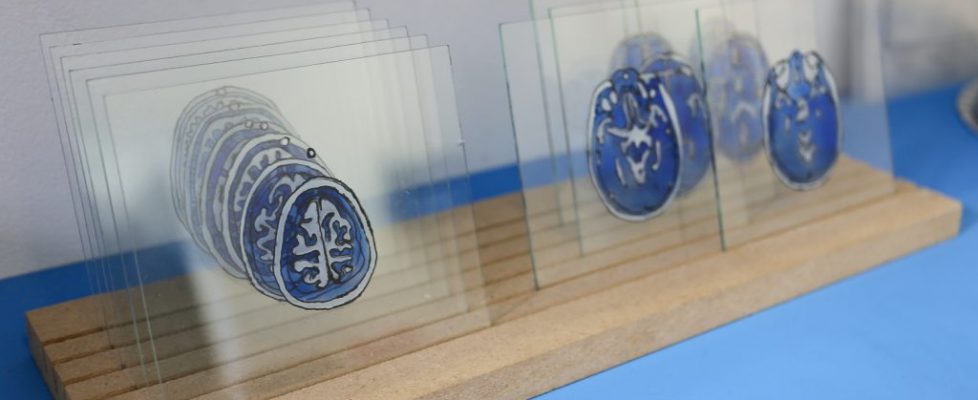Forced Connections and Rules of Random
How restrictions can make us more creative in art and teaching
—
Words by Stephen Bennett, with workshop observations from Lisa Pettibone and quotes from participants. Photos by Çağlar Tahiroğlu.

It is October 2016. The leaves are falling, yet it is a time of fresh promise for first-year students on Central Saint Martins’ masters programme in Art and Science. The new students are naturally a bit anxious, keen to impress their course leaders and their fellow students. What will their first artwork be? How to ensure it really shines? Perhaps stick with tried and tested methods, the kind of thing which gained entry to the programme in the first place. That worked well after all. But what is the point of joining a MA just to do the same old thing?

Second week, and the course leaders, Nathan Cohen and Heather Barnett, lull the students into a entertaining exercise. Sitting in groups, the students are asked to brainstorm lists of subject matter for art – death, immigration, philosophy, alienation. ‘Black holes!’ someone shouts. This is getting quite fun. Next, different methods for producing art. Painting, sculpting, drawing. But what about data experiments or tasting – how can that be practical? Finally, a list of materials to use in the production of art. Students are warmed up now. Rubber, plastic, cement… bacteria! Sports equipment!!
“Use the hammer to smash the patriarchy walnut!”
You may see what is about to happen – but the students didn’t. Heather delivers the coup de grace. Randomly assigning numbers, each student ends up with a unique combination of ‘matter-method-material’. This is the first project brief of the MA: to develop artwork based upon the ‘forced connections’ of a chance group of three words.
The initial result is… uproar amongst the students. But then, with a bit of coaching and support, the studio starts germinating some unusual pieces. Cola cans cling to the window. Folded paper sprouts from a wall. Knitted cushions appear and then start multiplying. A month later, and students are explaining works about immigration, developed through interviews, using bacteria as a material. A collaboration results in painted rocks, telling us about philosophy. Ink dripping down folded paper is a metaphor for alienation. Plastic, painted, reveals insights about communication networks. Just as the first crit is wrapping up, Heather delivers another bombshell. There is an opportunity to show these experimental pieces in a London gallery in a week’s time…

The display is part of the University of the Arts London’s recent Practices of Enquiry, an exhibition of experimental enquiry-based learning across UAL, featuring teaching methods from all colleges. Photos of the in-situ art are studded through this blog. The art is intended to inspire and provoke teaching staff across UAL. This is most evident in the Rules of Random workshop run by Heather. This event, for UAL teaching staff, uses the same techniques as the ‘forced connections’ project.
“How do you send an orange into space?”
This time unsuspecting participants brainstorm a list of ‘unusual groups of students’, ‘difficult subject matter’, and select random objects. The MA students are interspersed in the groups, now playing the role of coach. They help groups design lesson plans to teach mathematical pattern recognition to traditional wine makers using a compass. Participants consider how to use dried orange slices to teach astrophysics to 16 year olds. Ever used a walnut to teach sex education to linguists? What about using a blindfold to teach technoheads about Antarctic scuba diving? You can see some of the results in this blog.

The two sister exercises – Forced Connections in the studio, Rules of Random in the gallery – had a number of features in common. Perhaps most obviously they are conduits for unlocking creativity. Everyone can get stuck in a rut, whether producing art, teaching or working in an office. Restricting options can force lateral thinking and resourcefulness. Sometimes we are faced with two many choices or methods, and the possibilities can be paralysing. Sometimes – especially when doing something we are supposed to be good at – we live in fear of failure. But, when forced to use a sieve to teach tradesmen about crime, the failure becomes almost inevitable, and this permits a great willingness to take risk.
“What is the essence of a feather?”
A number of the CSM students are now incorporating the initially ridiculed combinations of matter-method-material into their main practice. Bacteria and immigration becomes a starting point for examining the semiotics around human relations. Folding and alienation has resulted paper-based in sculptures which morph between two and three dimensions. Similarly, feedback from the Rules of Random workshop participants was that it has opened up new teaching approaches. Food can be an excellent way of teaching 16 year olds about abstract concepts. Participatory lessons, especially ones involving blindfolds or smashing nuts, become instantly memorable. Objects can help focus learning into specific issues in a much broader topic.

These techniques can be adapted into practically any environment, with any task in mind. Please try them out, see if it can unlock a problem or open up a new line of enquiry. And remember: you must use whichever random combination you get!
—
The Rules of Random workshop was developed as part of Practices of Enquiry, a two-year enhancement project at UAL exploring how we create the conditions for enquiry to flourish within our ‘creative, curious, critical curricula’.
The workshop was devised and delivered by MA Art and Science lecturer, Heather Barnett, working with students: Olivia Bargman, Stephen Bennett, Joshua Bourke, Lisa Pettibone, Çağlar Tahiroğlu, and Bekk Wells.
